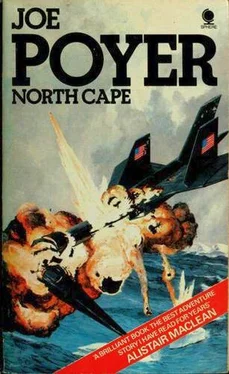On the eastern flank of the steep rock walls plummeting almost straight down, a cluster of needle-sharp rocks reared up jaggedly from the sea bottom. The glasses showed waves dashing themselves furiously, but in vain, at this miniature bastion. Plumes of spray were probably topping sixty feet, he thought to himself. Those rocks might present a hazard if they possessed an underwater ridge jutting away into the mouth. The western entrance was clear, at least of visible obstructions. At least two hundred feet separated the nearest possible approach for any underwater ridge extending from the eastern flank from the western walls, which were not quite as sheer in their drop to the water. There was barely enough room to take the battle cruiser through, but it could be done — if done carefully. Beyond the entrance there were only a few indications on the chart that suggested small islands. Once past the entrance, Larkin knew that he would be able to take the battle cruiser anywhere that the submarine could go. He did not trust the map, but he did trust the ability of the Soviet commander.
Twenty minutes later the Robert F. Kennedy was gently nosing her way past the entrance. The sonar gear showed an unexpected two hundred feet beneath her keel, even more than normal for Scandinavian fjords on exposed ocean coasts. Bridges was the conn and Larkin, with a microphone conveniently at hand, had again joined the lookouts on the catwalk. The slopes of the fjord slipping past were completely deserted, as they usually were. Only a fool would venture into this hellish terrain in these weather conditions — or even at midsummer for that matter. Not one sign of vegetation marred the granite structure of the walls. In sheltered recesses patches of snow could be seen, and occasionally long sheets of ice reaching from some unseen crevice stretched in a long icicle to the water. The walls on the eastern side were patently unscalable. Larkin knew that, unless the steepness and height of the cliffs grew less the deeper they penetrated, Folsom and his party could very well find themselves stuck on the cliff tops until the helicopter could be launched.
Larkin was heartened somewhat by the fact that the pitch and chop of the ship were lessening inside the fjord. The winds, obstructed by the narrow entrance, were rapidly diminishing in power and it was possible that the helicopter could be launched in a few hours. But for the moment the winds were blowing Force 6, between twenty-five and thirty-one miles per hour, and the waves running to five and six feet in a strange eddy of currents and crosscurrents deflected from the underwater walls. Time — Larkin needed time now more than anything else. What he was going to do when they spotted the submarine, he did not yet know. So far, past the entrance, he had been hugging the steep eastern wall, knowing that he would be invisible to the submarine’s sonar as the reflections from the underwater walls scrambled.
The microphone whistled at him.
“Captain, we have a sonar contact, possibly the submarine.”
“Bearing?”
“Dead ahead sir, on the western side. They are not using any ECM at all, so they must not suspect we are around. Range is five thousand yards.” Larkin thought for a moment. “Thank you.” He keyed the bridge channel. “Mr. Bridges, all engines stop. Run a check on the ship status.”
“Aye, sir.”
Larkin turned back to the railing and stared down the fjord. A shallow bend in the fjord wall blocked’ his view of the submarine less than three miles away. The sonar had picked up the submarine under an outthrust of the wall that did not extend more than a few feet below the water line. With the ship’s engines halted, the vicious rocking of the ship became more pronounced in the heavy chop. He watched the eastern wall, gauging to himself the speed at which they were being swept onto the knife-sharp ledges. It was faster than he expected. There was no possibility that they could maintain their position without running the engines. And if they did that, it would be only a matter of time before the submarine picked them up. Anchoring was out of the question. He needed mobility, instantaneous mobility. He could have that by standing outside the entrance and keeping an eye on what the submarine was doing.
For-the first time since taking command of the RFK, Larkin cursed the fact that she possessed no more than the 1.5-inch salute gun. With a four-inch cannon, or even an antiaircraft gun, he would have merely steamed around the curve, leveled the cannons, and called for a surrender. With the submarine facing away from them and riding on the surface, he could have blown her out of the water if she resisted. He almost hammered the railing in a measure of frustration. How in hell could he bring that damned submarine to terms? A boat party was out of the question… or was it? Ever since Teleman had been shot down, Larkin had been aching for a chance to take some kind of direct action. Five thousand yards. They could be on that damned submarine before they knew what was happening. If the hatches were closed, as they would be in this chop, a couple of charges of gelignite would take care of that. Lookouts could be dealt with. His mind raced furiously as he forced himself to remain calm. He would need the whaleboat, eight men, carbines, gelignite charges…
“Mr. Bridges, assemble an armed boat party.”
Ten minutes later Larkin sat in the stern sheets of the whaleboat with the tiller under his arm as they pulled away from the almost flush afterdeck. Feeling somewhat like Horatio Hornblower, he had buckled a revolver belt around his waist and stuck a flare pistol in his pocket. On his signal Bridges would bring the RFK around the headland and run down on the submarine. Unless a second flare was fired, his orders were to run the submarine under. Larkin and Bridges both knew that this was absolutely the last resort in case the armed attack by the nine men failed. The battle cruiser bows, cutting into the hull of the submarine, would crumple to the first main bulkhead if that happened. But in any event the submarine would be sitting on the bottom of the fjord. It would then be Bridges’ obligation to see that the same thing did not happen to the RFK. Behind him Larkin could hear the coughing of a second whaleboat starting up. Ten men were in that party and they would continue down the fjord to find Folsom’s party and render whatever assistance they could. It was probably a futile effort at best, but at least they had done everything they could. Larkin had sent a message direct to Virginia by satellite relay detailing his plans, but had not waited for a reply. Those short-sighted idiots would probably countermand his decisions.
Larkin took the whaleboat in as close to the narrow beach as he dared before turning parallel. The depth of the fjord made it possible for him to come within twenty yards of the rocky beach. Ahead, the jutting headland that screened the two ships from each other stood out boldly in the weak sunlight. Larkin could have wished for darkness, but he suspected that to wait for the remaining hour of daylight to pass could very well be too late. By the time they rounded the headland and came within a thousand yards of the ship, he judged that the sun would be dipping close enough to the horizon so that darkness would be almost complete within the fjord.
As the whaleboat puttered on with the muted roar of its muffled forty-horsepower engine, Larkin felt his own excitement reflecting back from the armed party. Each sat, staring forward, backs stiff with tension and hands firmly clasped around weapons. The gelignite charges were in two packs resting on the floorboards. One of the sailors had his foot resting on the top of the packs and a cord fastening both together looped around his wrist. Larkin reached down and picked his carbine up and ejected the clip, checked it, and then slammed it home. The sharp snap made the sailors jump. Larkin grinned at them and settled back against the thwart, portraying a relaxation he was far from feeling. He swung the tiller over, turning the bows to pass as close to the headland as possible, and looked back. The sunlight filtering down through the canyon was beginning to wane, but the bows-on silhouette of the RFK was sharply etched against the crack of blue-gray sky.
Читать дальше












